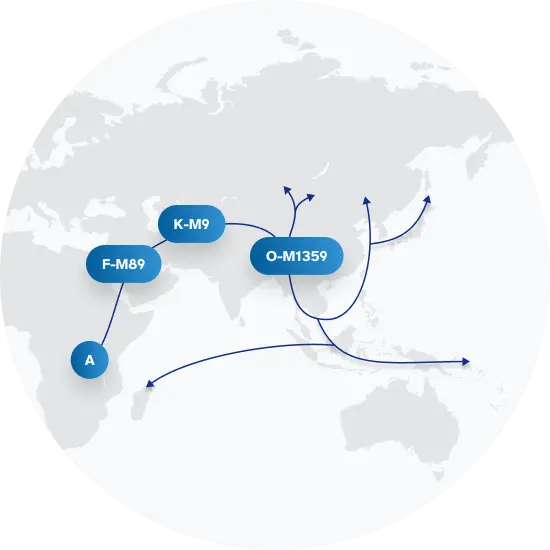Explore the Family Name Strayer
How common is the last name Strayer in the United States?
Based on the Decennial U.S. Census data, the surname Strayer has seen a slight decrease in popularity over a decade from 2000 to 2010. In the year 2000, Strayer was ranked 8,636 among all surnames in the United States; however, by 2010 it had slipped slightly to rank 8,994, marking a decrease of approximately 4.15%. Despite this, the number of individuals bearing the Strayer surname has actually increased during the same period, from 3,505 in 2000 to 3,636 in 2010, representing a growth of around 3.74%. However, when considering its proportion per 100,000 people, the figure dropped by about 5.38% over the decade.
| 2000 | 2010 | Change | |
|---|---|---|---|
| Rank | #8,636 | #8,994 | -4.15% |
| Count | 3,505 | 3,636 | 3.74% |
| Proportion per 100k | 1.3 | 1.23 | -5.38% |
Race and Ethnicity of people with the last name Strayer
In terms of ethnicity, according to the Decennial U.S. Census, the majority of individuals with the Strayer surname identify as White, accounting for 96.29% in 2000 and slightly decreasing to 94.75% by 2010. The second most common ethnic identity is Hispanic, which saw an increase of 39.18%, growing from 1.94% to 2.70% over the ten-year span. Interestingly, those identifying as two or more races also saw significant growth, increasing by 78.38% between 2000 and 2010. Other ethnic identities associated with the Strayer surname include Asian/Pacific Islander, Black, and American Indian/Alaskan Native, each of which experienced increases throughout the decade.
| 2000 | 2010 | Change | |
|---|---|---|---|
| White | 96.29% | 94.75% | -1.6% |
| Hispanic | 1.94% | 2.7% | 39.18% |
| Two or More Races | 0.74% | 1.32% | 78.38% |
| Asian/Pacific Islander | 0.54% | 0.58% | 7.41% |
| Black | 0.34% | 0.47% | 38.24% |
| American Indian and Alaskan Native | 0.14% | 0.19% | 35.71% |
Strayer ancestry composition
23andMe computes an ancestry breakdown for each customer. People may have ancestry from just one population or they may have ancestry from several populations. The most commonly-observed ancestry found in people with the surname Strayer is French & German, which comprises 41.2% of all ancestry found in people with the surname. The next two most common ancestries are British & Irish (36.1%) and Eastern European (4.7%). Additional ancestries include Ashkenazi Jewish, Italian, Scandinavian, Spanish & Portuguese, and Korean.
Ready to learn more about your ancestry? Get the most comprehensive ancestry breakdown on the market by taking our DNA test. Shop 23andMe
| ANCESTRY BREAKDOWN | COMPOSITION |
|---|---|
| French & German | 41.2% |
| British & Irish | 36.1% |
| Eastern European | 4.7% |
| Other | 18.0% |

Possible origins of the surname Strayer
Your DNA provides clues about where your recent ancestors may have lived. Having many distant relatives in the same location suggests that you may all share common ancestry there. Locations with many distant relatives can also be places where people have migrated recently, such as large cities. If a large number of individuals who share your surname have distant relatives in a specific area, it could indicate a connection between your surname and that location, stemming from either recent ancestral ties or migration.
Based on 23andMe data, people with last name Strayer have recent ancestry locations in the United Kingdom of Great Britain and Northern Ireland and Ireland.
| RECENT ANCESTRY Location | Percentage |
|---|---|
| West Midlands, United Kingdom | 83.30% |
| Greater Manchester, United Kingdom | 83.30% |
| Glasgow City, United Kingdom | 83.30% |
| Tyne And Wear, United Kingdom | 83.30% |
| Merseyside, United Kingdom | 83.30% |
What Strayer haplogroups can tell you
Haplogroups are genetic population groups that share a common ancestor on either your paternal or maternal line. These paternal and maternal haplogroups shed light on your genetic ancestry and help tell the story of your family.
The top paternal haplogroup of people with the surname Strayer is O-F2415, which is predominantly found among people with East Asian & Indigenous American ancestry. Haplogroup O-F2415 is descended from haplogroup O-M1359. Other common haplogroups include E-M183 and O-F2859, which are predominantly found among people with European and East Asian & Indigenous American ancestry.
The most common maternal haplogroups of people with Strayer surname are: H1, N, H. These most commonly trace back to individuals of European ancestry.
 Paternal Haplogroup Origins O-M1359
Paternal Haplogroup Origins O-M1359
Your paternal lineage may be linked to the Cham
One of the many populations harboring members of haplogroup O1b1a1a1a1 is the Cham ethnic group, a group of people who speak Austronesian languages in Mainland Southeast Asia. Austronesian languages make up a language family that is extremely large and widespread, comprising over 350 million people on islands such as Madagascar, Easter Island, and many others. However, Austronesian languages are less common on mainland Asia, with a notable exception being the Chamic language. Research suggests that ancestors of the Cham people migrated from Southeast Asian islands to the mainland around the year 500 BCE, and that early Cham populations quickly began mixing with indigenous southern Vietnamese populations. As a result, the Chamic language now has words that were borrowed from languages spoken by indigenous Vietnamese people. It is likely that an ancestral Kinh population was one of the populations that mixed with the Cham people shortly after their migration to mainland Asia.
Your maternal lineage may be linked to the nomadic Tuareg of the Sahara
Though haplogroup H1 rarely reaches high frequencies beyond western Europe, over 60% of eastern Tuareg in Libya belong to haplogroup H1. The Tuareg call themselves the Imazghan, meaning “free people.” They are an isolated, semi-nomadic people who inhabit the West-Central Sahara and are known today for a distinctive dark blue turban worn by the men, and for their long history as gatekeepers of the desert.How did women carrying H1 make it all the way from western Europe to this isolated community? They likely migrated from Spain across the Strait of Gibraltar into Morocco after the Last Ice Age, where they were assimilated into the Berbers of the Mediterranean coast. Then, about 5,000 years ago, the Sahara shifted from a period of relative habitable conditions to its dramatically arid desert environment. This shift may have caused migrations throughout the Sahara, prompting the ancient Tuaregs to meet and mingle with the Berbers, bringing H1 lineages into their population.

What do people with the surname Strayer have in common?
Spoiler alert: it's complicated. People with the same last name are usually no more genetically similar than a randomly sampled group of people from the same population. That said, people with the same surname are more likely to have similar ancestries than randomly sampled individuals. The reason is the tendency of people with similar cultural or geographical backgrounds to preferentially mate with one another. That's why people who share a surname may be more likely to share traits and tendencies in common than people within the general population. Check out the percentages below to see the prevalences of tastes, habits, and traits of people with your surname compared with prevalences among 23andMe users.
Preferences
Traits
Habits
Wellness

Migraine
A severe headache characterized by intense pain, sensitivity to light and sound, and often accompanied by nausea and vomiting.
"Strayer" Surname 13.1%
23andMe Users 16.4%
Are health conditions linked to the last name Strayer?
The short answer is that, if there is an association between surname and health, it's usually more about your ancestry than your name. Individuals with a given surname are no more genetically similar than the general population but often have similar ancestries. The populations of people associated with those shared ancestries often have sets of genetic variations, also known as alleles, in common. Some of those alleles are associated with a greater likelihood of developing certain diseases.
Disease variant frequency by ancestry
Disease allele frequencies in populations associated with the surname Strayer are shown below. Important Note: not everyone with a disease allele will develop these health condition














